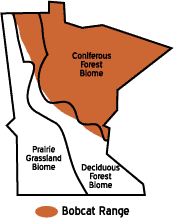
The bobcat is the most common of Minnesota's three native wildcat species (the others are the cougar and Canada lynx). About 2,000 bobcats live in northern Minnesota. Few humans ever see a bobcat in the wild, but about 200 are taken each winter by licensed trappers.
General description: A medium-sized animal with a very short "bob" (which means cut short) tail, with light brown or gray fur on the top and white fur, often with black spots, on the belly.
Length: Adults are 26 to 36 inches long, plus a 4- to 7-inch tail.
Weight: Adult females weigh 20 to 25 pounds, and adult males about 30 pounds.
Color: Brown or gray on top, white on the belly often with black spots.
Baby bobcats are usually born during late March through May in a litter of 2 to 4 kittens. Sometimes they are born as late as September. Dens are often in a brush pile or fallen hollow tree. Kittens stay with their mother for nearly one year before moving on to find their own home range.
The bobcat eats a wide range of small and medium-sized prey including mice, snowshoe hares, squirrels, birds, and white-tailed deer fawns. The bobcat can kill an adult deer by pouncing on the deer's neck from an over-hanging tree limb and piercing the jugular vein in the deer's neck with its teeth.
Other predator species such as the fisher and coyote may compete with the bobcat for food and habitat and sometimes will kill a bobcat. A bobcat will also kill a fisher or coyote, if given the chance.

Bobcats used to live across Minnesota, but now they live only in northern Minnesota forests. They prefer habitat that has lots of prey, such as young aspen forests and cedar swamps, where deer congregate in winter.
Minnesota's bobcat population stays stable at around 2,000. The short hunting and trapping season does not harm the population.
The bobcat is named for its "bob" tail, which looks
as though it has been cut off at about 5 inches long. It easily climbs trees,
and sometimes catches and eats porcupines which also climb trees.
![]()